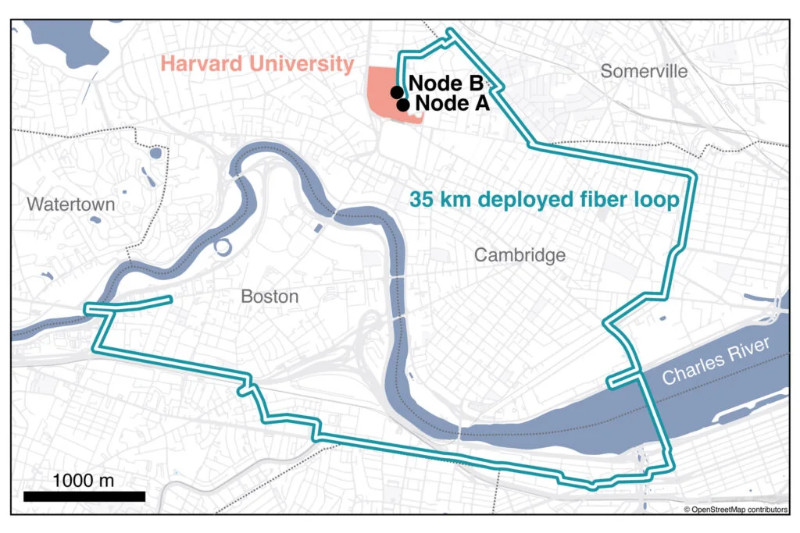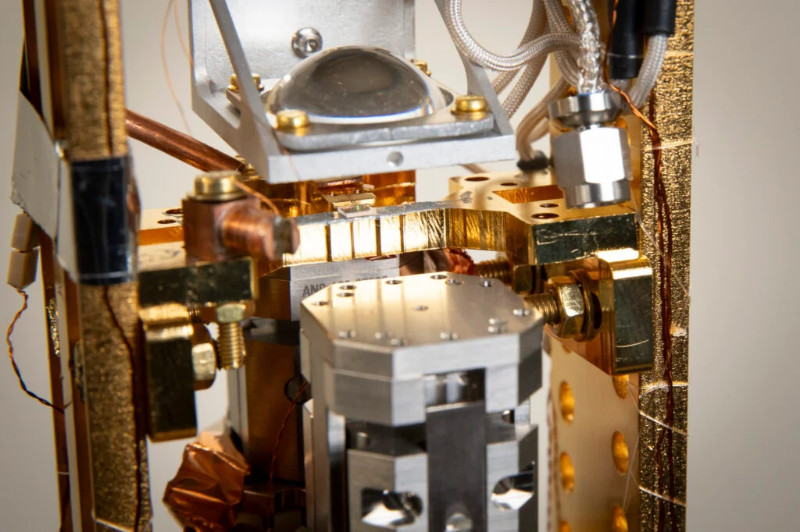Physicists Demo First Metro-Area Quantum Computer Network in Boston
It’s one thing to dream up a next-generation quantum internet capable of sending highly complex, hacker-proof information around the world at ultra-fast speeds. It’s quite another to physically show it’s possible.
That’s exactly what Harvard physicists have done, using existing Boston-area telecommunication fiber, in a demonstration of the world’s longest fiber distance between two quantum memory nodes. Think of it as a simple, closed internet carrying a signal encoded not by classical bits like the existing internet, but by perfectly secure, individual particles of light.
The groundbreaking work, published in Nature, was led by Mikhail Lukin, the Joshua and Beth Friedman University Professor in the Department of Physics, in collaboration with Harvard professors Marko Lončar and Hongkun Park, who are all members of the Harvard Quantum Initiative. The Nature work was carried out with researchers at Amazon Web Services.
The Harvard team established the practical makings of the first quantum internet by entangling two quantum memory nodes separated by optical fiber link deployed over a roughly 22-mile loop through Cambridge, Somerville, Watertown, and Boston. The two nodes were located a floor apart in Harvard’s Laboratory for Integrated Science and Engineering.

Credit: Can Knaut via OpenStreetMap
Quantum memory, analogous to classical computer memory, is an important component of a quantum computing future because it allows for complex network operations and information storage and retrieval. While other quantum networks have been created in the past, the Harvard team’s is the longest fiber network between devices that can store, process, and move information.
Each node is a very small quantum computer, made out of a sliver of diamond that has a defect in its atomic structure called a silicon-vacancy center. Inside the diamond, carved structures smaller than a hundredth the width of a human hair enhance the interaction between the silicon-vacancy center and light.
The silicon-vacancy center contains two qubits, or bits of quantum information: one in the form of an electron spin used for communication, and the other in a longer-lived nuclear spin used as a memory qubit to store entanglement, the quantum-mechanical property that allows information to be perfectly correlated across any distance.
In classical computing, information is stored and transmitted as a series of discrete binary signals, say on/off, that form a kind of decision tree. Quantum computing is more fluid, as information can exist in stages between on and off, and is stored and transferred as shifting patterns of particle movement across two entangled points.
Using silicon-vacancy centers as quantum memory devices for single photons has been a multiyear research program at Harvard. The technology solves a major problem in the theorized quantum internet: signal loss that can’t be boosted in traditional ways.
A quantum network cannot use standard optical-fiber signal repeaters because simple copying of quantum information as discrete bits is impossible — making the information secure, but also very hard to transport over long distances.
Silicon-vacancy-center-based network nodes can catch, store, and entangle bits of quantum information while correcting for signal loss. After cooling the nodes to close to absolute zero, light is sent through the first node and, by nature of the silicon vacancy center’s atomic structure, becomes entangled with it, so able to carry the information.

“Since the light is already entangled with the first node, it can transfer this entanglement to the second node,” explained first author Can Knaut, a Kenneth C. Griffin Graduate School of Arts and Sciences student in Lukin’s lab. “We call this photon-mediated entanglement.”
Over the last several years, the researchers have leased optical fiber from a company in Boston to run their experiments, fitting their demonstration network on top of the existing fiber to indicate that creating a quantum internet with similar network lines would be possible.
“Showing that quantum network nodes can be entangled in the real-world environment of a very busy urban area is an important step toward practical networking between quantum computers,” Lukin said.
A two-node quantum network is only the beginning. The researchers are working diligently to extend the performance of their network by adding nodes and experimenting with more networking protocols.
The paper is titled “Entanglement of Nanophotonic Quantum Memory Nodes in a Telecom Network.” The work was supported by the AWS Center for Quantum Networking’s research alliance with the Harvard Quantum Initiative, the National Science Foundation, the Center for Ultracold Atoms (an NSF Physics Frontiers Center), the Center for Quantum Networks (an NSF Engineering Research Center), the Air Force Office of Scientific Research, and other sources.




































